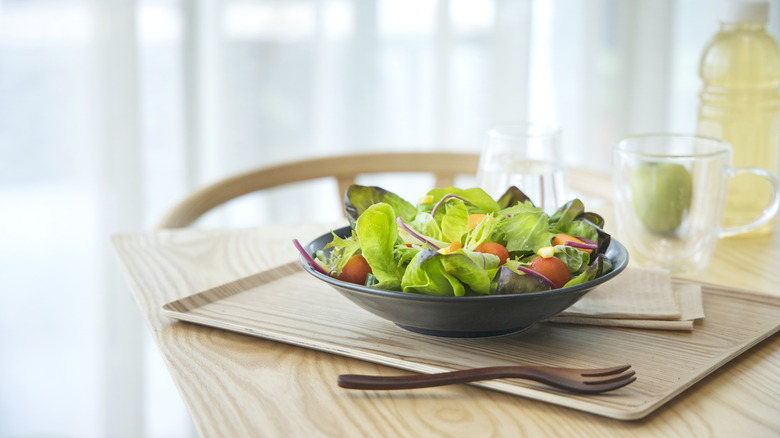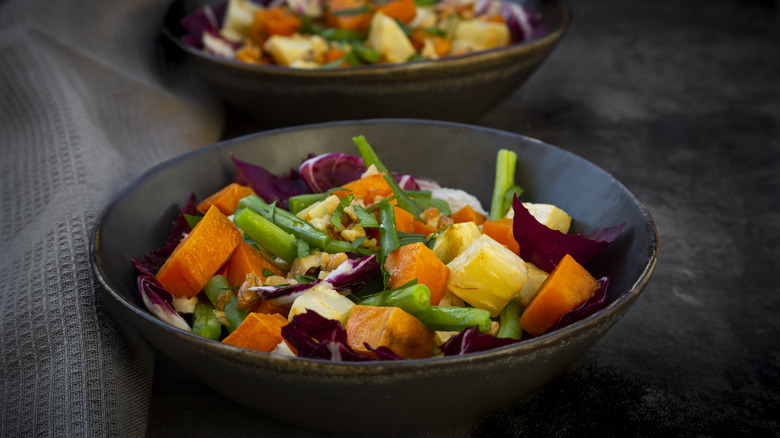Make Bagged Salad Feel More Like A Full Meal With One Easy Addition
As far as salad-fanatics go, a crunchy, colorful, and veggie-dense mealtime is unbeatable. But for some, there is nothing worse than finishing a bowl of leafy greens and feeling that hint of hunger lingering in the background. No amount of restaurant-worthy Caesar salad dressing can mask the fact that you're still craving a bowl (or two) more. The trick that could really spruce up your store-bought bagged salad (and stop stomach rumbles) is incorporating some warm vegetables for a plate that is truly filling. Yep, heartier salads might just be the way forward.
Even though convenient, bagged salads can feel a little too light for the occasion sometimes, be it a dinner party or an attempt to satisfy the family with a healthier lunch that everyone can get on board with. Bagged salads often come pre-washed and are essentially ready to go with a drizzle of your favorite sauce or citrus, but it still might not hit the spot. Warming up vegetables offers a much-needed surprise to the tastebuds with a mix of temperatures and textures while also filling you up. Any leftover vegetable salad can also double up here as a repurposed tasty meal or a versatile side dish. Just revive it with a sprinkling of crumbled feta cheese and nuts for a new lease of life.
The scanty looking bagged salads that lack oomph also get a flavor upgrade no matter how boldly or subtly you include warm veg. Whether you take inspiration from a carb-dense potato salad or go full-on with a baked salad, your options are varied. As far as cooking techniques go, you can experiment with any method that suits you, but grilling, sautéing, steaming, or roasting are some ways that go down a treat.
Two methods for adding warmed vegetables to your bagged salad
There are many options to choose from when adding warm vegetables to bolster up salads. Roasted vegetables are the perfect way to balance out a salad with sweetness, because the process of roasting causes them to caramelize and become extra tender. Vegetables such as carrots, beets, onions, and sweet potatoes make for a salad that boasts a natural sweetness and a softer texture. Some more great options to chop up and roast include potatoes (try roasting your potatoes with rosemary and garlic for a winning flavor palette) alongside butternut squash and parsnips, which are especially good if you like a hint of creaminess in your roast vegetables.
Another fantastic option is to try sautéing vegetables to incorporate warmth into your salad. Sautéing has the benefit of being quick, which is ideal for most salad-makers. It also allows veggies to lose some of the hard crunch and replace it with a golden, caramelized taste that absorbs the flavors of the pan. If you have a sauté pan, you'll want to crack this out. Or, grab a large frying pan or a cast iron skillet to give your veggies the best chance of sautéing well. Some great vegetables to consider for a sautéed salad include garlic cloves and shallots for aromatics, and zucchini, bell peppers, mushrooms, and asparagus for a juicy and colorful mix of veggies. You can reach for some avocado oil for a neutral fat, or olive oil for something slightly more full-bodied in your salad. If you're not feeling like adding heavy oils, you could always opt for the brilliant oil-free sautéed vegetable method that uses water to keep things light and fresh.

